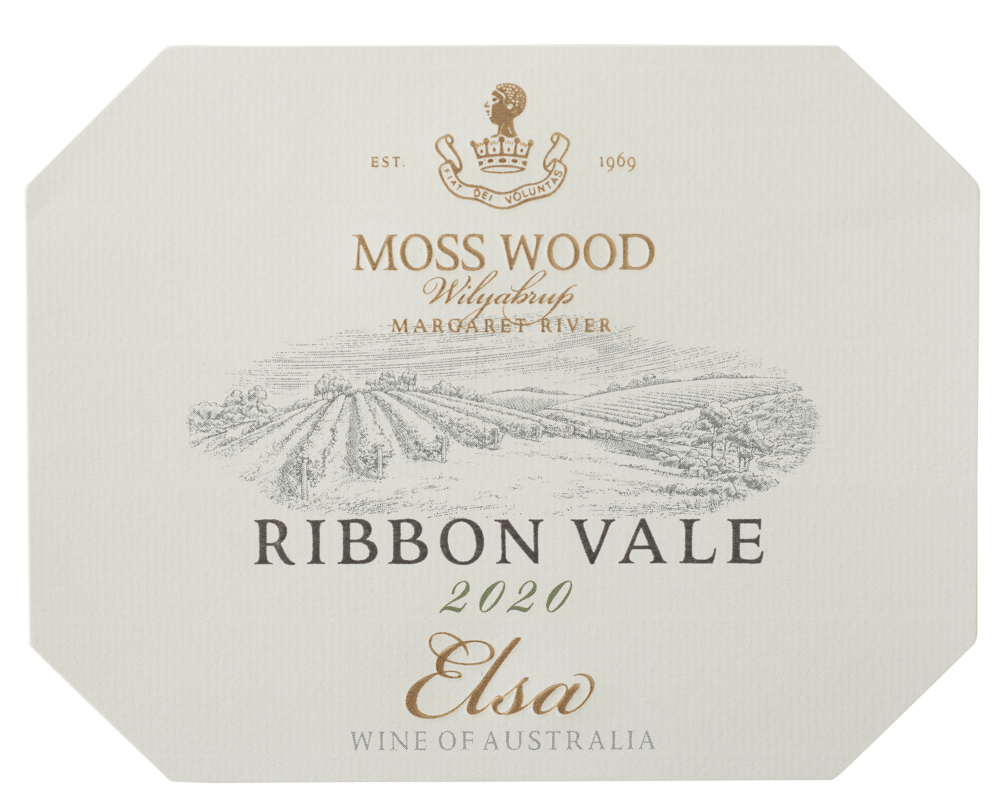Moss Wood Ribbon Vale 2020 Elsa

| Wine Facts | |
|---|---|
| Median Harvest Date | 15/02/2020 |
| Harvest Ripeness | 12.8 °Be |
| Yield | 8.01 t/ha |
| Day Elapsed between Flowering and Harvest | 88 days |
| Bottled | 15/01/2021 |
| Released | 29/10/2021 |
| Alcohol | 14.0% |
| Wine Facts | |
|---|---|
| Median Harvest Date | 15/02/2020 |
| Harvest Ripeness | 12.8 °Be |
| Yield | 8.01 t/ha |
| Day Elapsed between Flowering and Harvest | 88 days |
| Bottled | 15/01/2021 |
| Released | 29/10/2021 |
| Alcohol | 14.0% |
VINTAGE NOTES
After the challenges of the 2018-19 growing season, the story of 2019-20 is one of delightful simplicity. It is true that rainfall in calendar year 2019 was a little on the low side, with 779mm rain compared with our average of 1000mm but that was still plenty for the vines.
Sauvignon Blanc flowered slightly early on 15th November in near-perfect conditions. There were only a few odd showers of rain and temperatures were nice and warm. Indeed, across the entire growing season, we averaged 20.1°C, which is just about perfect for grape ripening. We had no disease issues and although the birds were a bit hungry, we kept them at bay with the nets. Sauvignon Blanc sailed through to full ripeness of 12.8° Baume 12 days ahead of average on 15th February.
Surely even the grumpiest farmer couldn’t complain?
Well, yes, we can - the trick was in the yield. We knew as we filled the bins in the vineyard the crop was lighter than we’d hoped and sure enough, once we started weighing it at the winery it was clear things were well down. Sauvignon Blanc, normally very reliable was reduced by an irritating 25% to 8.01 tonnes per hectare. For the explanation, we have to go all the way back to spring, October 24th, in fact, when a very solid hailstorm in the wee small hours gave Wilyabrup a fair belting. Such is life.
PRODUCTION NOTES
Since our change to the new style for the “Elsa” with the 2019 vintage, we have plenty of fun with Sauvignon Blanc in the winery. The new technique allows us to use our imagination and explore the complex end of winemaking.
Oh, and because we’re Moss Wood and such big fans of Semillon, we like to have some of that in the blend, 10% in the 2020 wine.
It adds complexity to the nose and depth to the palate, even at this small percentage. Also, in a departure from our “normal” Semillon production, in the Elsa it gets all the same fancy techniques that we apply to the Sauvignon Blanc.
After sorting and pressing, the must is settled for 48 hours in stainless steel then the clear juice is racked to a second tank to commence fermentation. Where we once fermented crystal clear Sauvignon Blanc, now we leave it very slightly cloudy, seeking some lightly caramel notes from the solids. Multiple yeast strains are then introduced for primary fermentation and these add further nuances to both the nose and the palate.
Once the ferment has reached the halfway mark, the juice is then racked to French oak barriques of which 6% were new. We are not looking for strong oak notes in this wine but certainly want the benefits of the improved palate weight from fermentation in small oak, as well as the evolution of the yeasty, bready notes as the wine ages on lees.
After primary fermentation we encouraged the secondary fermentation, something that can be challenging for the very temperature-sensitive malolactic bacteria when the winery begins to cool off as autumn sets in. Patience is a virtue and by the end of June it was finally complete. If visitors to Moss Wood ever wonder why there are rows of barrels sitting outside on a sunny day in May, the answer is simple. We need every bit of warmth we can find to keep the Sauvignon Blanc secondary fermentation going.
Once this was finished, the wine was racked to stainless steel, blended and adjusted for sulphur dioxide then returned to barrel, where it stayed for a total of 9 months. On 5th January 2021 it was racked and blended in stainless steel, fined with bentonite for protein stability and then sterile filtered and bottled on 15th January.
Tasting Notes
Colour and condition:
Light to medium straw hue; bright condition.
Nose:
Lifted scents of lychee, gooseberry and passionfruit, with caramel and a spiciness, reminiscent of nutmeg, with freshly baked pastry. In the background is a touch of toasty oak..
Palate:
The initial impression follows the nose with generous caramel and lychee flavours sitting over full body and lively acidity, with leafy notes at the end. There is some tannin but the finish is clean, courtesy of the concentration and good length of flavour.
Cellaring:
From a relatively small crop and with good concentration, there is no doubt the wine will cellar well. The lively fruit notes will form the major part of the wine for at least 5 years but as it approaches 10 years of age, the secondary notes should start to play a role. Therefore, for those wanting to see some aging, we suggest a minimum of 10 years cellaring.
